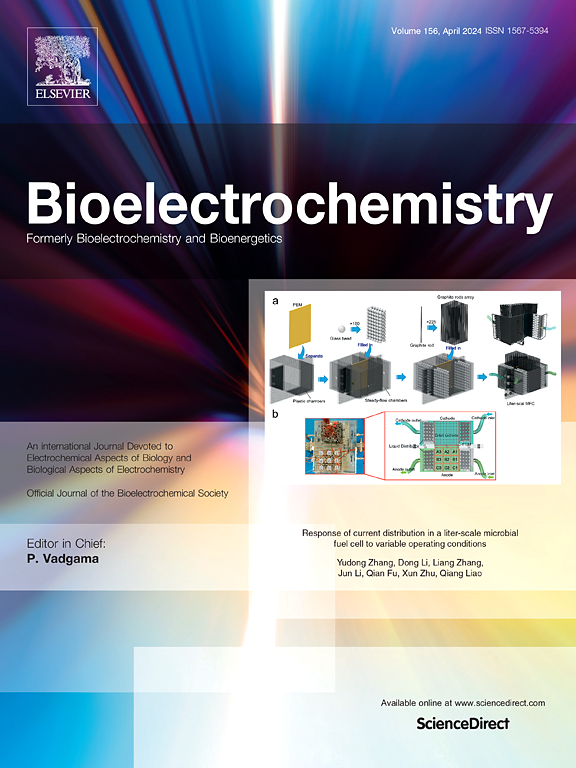在流体状电极上引入表面氧基团,促进硫还原地杆菌的生物膜生长,允许连续操作
IF 4.8
2区 化学
Q1 BIOCHEMISTRY & MOLECULAR BIOLOGY
引用次数: 0
摘要
微生物电化学流态化反应器(ME-FBR)将电活性细菌的生长模式从生物膜策略转变为浮游模式,同时在没有氧化还原介质的情况下仍然进行氧化代谢的直接胞外电子转移。在ME-FBR中选择玻璃碳作为浮游硫还原地杆菌生长材料。然而,该材料无法保留电池,因此意味着连续操作的应用已经受到损害。在这种情况下,考虑到地杆菌属细菌形式的最外层膜上存在大量的细胞色素C,采用了量身定制的化学策略。在本研究中,对一种商用玻璃碳(GC)进行了以羧基为主的表面氧基(SOGs)的化学修饰,其表面氧基(SOGs)与细胞色素c的血红素基团具有很高的亲和力。功能化材料保留了结构和质地特征,并且i)促进了以乙酸为唯一碳和电子供体源的Geobacter生物膜的形成,ii)与原始碳相比,增加了电流密度和乙酸脱除率。因此,富含羧基型SOGs的新材料有助于电活性细菌从基于浮游生物的策略向基于生物膜的策略过渡,从而可以将ME-FBR操作从批量扩展到连续模式,同时仍然可以实现电流。本文章由计算机程序翻译,如有差异,请以英文原文为准。

The introduction of surface oxygen groups on fluid-like electrodes enhances biofilm growth of Geobacter sulfurreducens allowing continuous operation
Microbial Electrochemical Fluidized Reactors (ME-FBR) changed the paradigm for growing electroactive bacteria from a biofilm strategy to a planktonic mode, while still performing direct extracellular electron transfer from oxidative metabolism in absence of redox mediators. Glassy carbon was the material selected for growing planktonic Geobacter sulfurreducens in ME-FBR. However, the material was unable to retain cells so applications implying continuous operation have been compromised. In this context, a tailor-made chemical strategy was followed considering the large amount of cytochromes C present on the outermost membrane of bacteria form of the Geobacter genus. In this work, a commercial glassy carbon (GC) was chemically modified with surface oxygen groups (SOGs) mainly carboxylic type with high affinity for heme group of cytochrome C. The functionalized material did conserve the structural and textural features and i) promoted the biofilm formation of Geobacter using acetate as sole carbon and electron donor source, and ii) increased the current density and acetate removal rate in comparison with pristine carbon. Thus, the new material enriched in carboxylic-type SOGs facilitates a-la-carte anchorage of electroactive bacteria to move on from a planktonic-based to a biofilm-based strategy, so ME-FBR operation could be expanded from batch to continuous mode, while electrical current was still possible.
求助全文
通过发布文献求助,成功后即可免费获取论文全文。
去求助
来源期刊

Bioelectrochemistry
生物-电化学
CiteScore
9.10
自引率
6.00%
发文量
238
审稿时长
38 days
期刊介绍:
An International Journal Devoted to Electrochemical Aspects of Biology and Biological Aspects of Electrochemistry
Bioelectrochemistry is an international journal devoted to electrochemical principles in biology and biological aspects of electrochemistry. It publishes experimental and theoretical papers dealing with the electrochemical aspects of:
• Electrified interfaces (electric double layers, adsorption, electron transfer, protein electrochemistry, basic principles of biosensors, biosensor interfaces and bio-nanosensor design and construction.
• Electric and magnetic field effects (field-dependent processes, field interactions with molecules, intramolecular field effects, sensory systems for electric and magnetic fields, molecular and cellular mechanisms)
• Bioenergetics and signal transduction (energy conversion, photosynthetic and visual membranes)
• Biomembranes and model membranes (thermodynamics and mechanics, membrane transport, electroporation, fusion and insertion)
• Electrochemical applications in medicine and biotechnology (drug delivery and gene transfer to cells and tissues, iontophoresis, skin electroporation, injury and repair).
• Organization and use of arrays in-vitro and in-vivo, including as part of feedback control.
• Electrochemical interrogation of biofilms as generated by microorganisms and tissue reaction associated with medical implants.
 求助内容:
求助内容: 应助结果提醒方式:
应助结果提醒方式:


